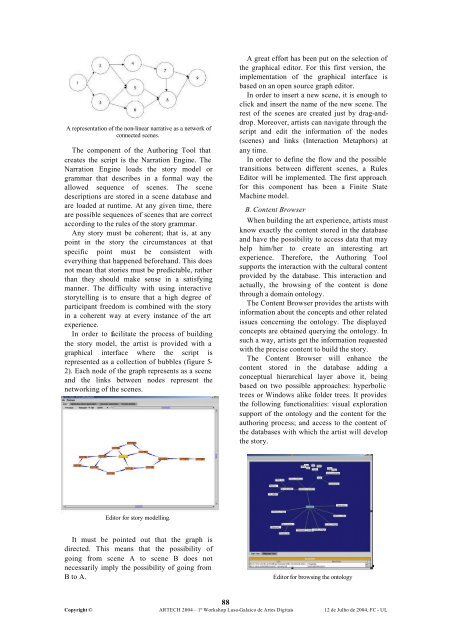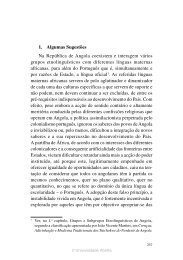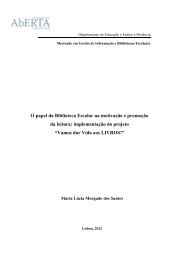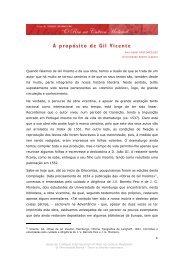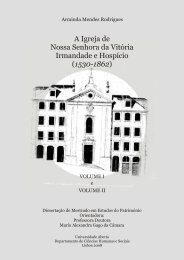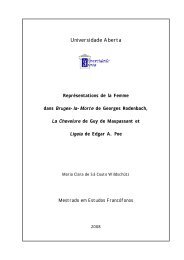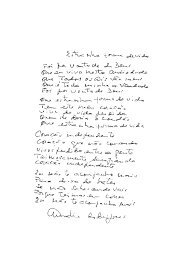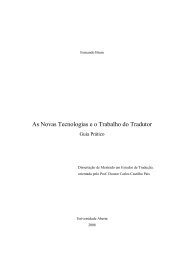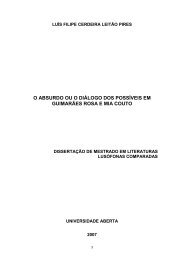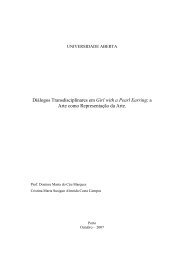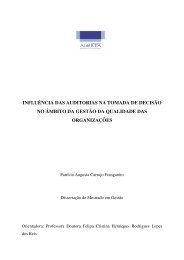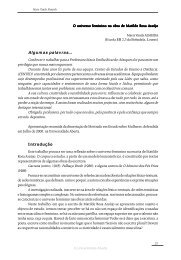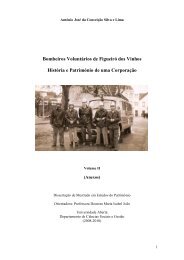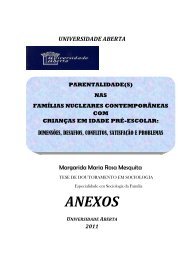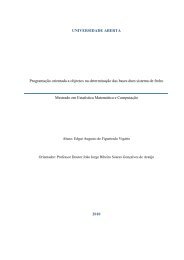NA SENDA DA IMAGEM A Representação ea Tecnologia na Arte
NA SENDA DA IMAGEM A Representação ea Tecnologia na Arte
NA SENDA DA IMAGEM A Representação ea Tecnologia na Arte
You also want an ePaper? Increase the reach of your titles
YUMPU automatically turns print PDFs into web optimized ePapers that Google loves.
A representation of the non-lin<strong>ea</strong>r <strong>na</strong>rrative as a network of<br />
connected scenes.<br />
The component of the Authoring Tool that<br />
cr<strong>ea</strong>tes the script is the Narration Engine. The<br />
Narration Engine loads the story model or<br />
grammar that describes in a formal way the<br />
allowed sequence of scenes. The scene<br />
descriptions are stored in a scene database and<br />
are loaded at runtime. At any given time, there<br />
are possible sequences of scenes that are correct<br />
according to the rules of the story grammar.<br />
Any story must be coherent; that is, at any<br />
point in the story the circumstances at that<br />
specific point must be consistent with<br />
everything that happened beforehand. This does<br />
not m<strong>ea</strong>n that stories must be predictable, rather<br />
than they should make sense in a satisfying<br />
manner. The difficulty with using interactive<br />
storytelling is to ensure that a high degree of<br />
participant freedom is combined with the story<br />
in a coherent way at every instance of the art<br />
experience.<br />
In order to facilitate the process of building<br />
the story model, the artist is provided with a<br />
graphical interface where the script is<br />
represented as a collection of bubbles (figure 5-<br />
2). Each node of the graph represents as a scene<br />
and the links between nodes represent the<br />
networking of the scenes.<br />
Editor for story modelling.<br />
It must be pointed out that the graph is<br />
directed. This m<strong>ea</strong>ns that the possibility of<br />
going from scene A to scene B does not<br />
necessarily imply the possibility of going from<br />
B to A.<br />
A gr<strong>ea</strong>t effort has been put on the selection of<br />
the graphical editor. For this first version, the<br />
implementation of the graphical interface is<br />
based on an open source graph editor.<br />
In order to insert a new scene, it is enough to<br />
click and insert the <strong>na</strong>me of the new scene. The<br />
rest of the scenes are cr<strong>ea</strong>ted just by drag-anddrop.<br />
Moreover, artists can <strong>na</strong>vigate through the<br />
script and edit the information of the nodes<br />
(scenes) and links (Interaction Metaphors) at<br />
any time.<br />
In order to define the flow and the possible<br />
transitions between different scenes, a Rules<br />
Editor will be implemented. The first approach<br />
for this component has been a Finite State<br />
Machine model.<br />
B. Content Browser<br />
When building the art experience, artists must<br />
know exactly the content stored in the database<br />
and have the possibility to access data that may<br />
help him/her to cr<strong>ea</strong>te an interesting art<br />
experience. Therefore, the Authoring Tool<br />
supports the interaction with the cultural content<br />
provided by the database. This interaction and<br />
actually, the browsing of the content is done<br />
through a domain ontology.<br />
The Content Browser provides the artists with<br />
information about the concepts and other related<br />
issues concerning the ontology. The displayed<br />
concepts are obtained querying the ontology. In<br />
such a way, artists get the information requested<br />
with the precise content to build the story.<br />
The Content Browser will enhance the<br />
content stored in the database adding a<br />
conceptual hierarchical layer above it, being<br />
based on two possible approaches: hyperbolic<br />
trees or Windows alike folder trees. It provides<br />
the following functio<strong>na</strong>lities: visual exploration<br />
support of the ontology and the content for the<br />
authoring process; and access to the content of<br />
the databases with which the artist will develop<br />
the story.<br />
Editor for browsing the ontology<br />
88<br />
Copyright © ARTECH 2004 – 1º Workshop Luso-Galaico de <strong>Arte</strong>s Digitais 12 de Julho de 2004, FC - UL


